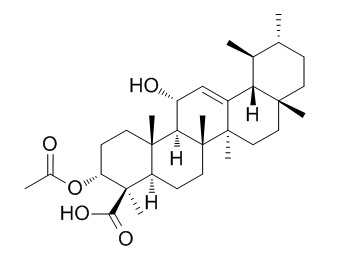3-O-Acetyl-11-hydroxy-beta-boswellic acid
3-O-Acetyl-11-hydroxy-beta-boswellic acid is the precursor of 3-O-acetyl-9, 11-dehydro-beta-boswellic acid(a 5-lipoxygenase inhibitor ).
Inquire / Order:
manager@chemfaces.com
Technical Inquiries:
service@chemfaces.com
Tel:
+86-27-84237783
Fax:
+86-27-84254680
Address:
1 Building, No. 83, CheCheng Rd., Wuhan Economic and Technological Development Zone, Wuhan, Hubei 430056, PRC
Providing storage is as stated on the product vial and the vial is kept tightly sealed, the product can be stored for up to
24 months(2-8C).
Wherever possible, you should prepare and use solutions on the same day. However, if you need to make up stock solutions in advance, we recommend that you store the solution as aliquots in tightly sealed vials at -20C. Generally, these will be useable for up to two weeks. Before use, and prior to opening the vial we recommend that you allow your product to equilibrate to room temperature for at least 1 hour.
Need more advice on solubility, usage and handling? Please email to: service@chemfaces.com
The packaging of the product may have turned upside down during transportation, resulting in the natural compounds adhering to the neck or cap of the vial. take the vial out of its packaging and gently shake to let the compounds fall to the bottom of the vial. for liquid products, centrifuge at 200-500 RPM to gather the liquid at the bottom of the vial. try to avoid loss or contamination during handling.
Horticulture Research2023, uhad259
Journal of Functional Foods2022, 99: 105331.
Pharm Biol.2017, 55(1):360-366
Molecules.2024, 29(17):4034.
J Ethnopharmacol.2023, 309:116302.
Food and Agriculture Org. Of the UN2019, 151-160
Molecules.2019, 24(16):E2985
Front Microbiol.2023, 14:1232039.
Biomol Ther (Seoul).2024, 32(2):214-223.
Phytomedicine.2019, 61:152813
Related and Featured Products
Daru. 2013 Jan 2;21(1):2.
Urease inhibitory activities of β-boswellic acid derivatives.[Pubmed:
23351363 ]
Boswellia carterii have been used in traditional medicine for many years for management different gastrointestinal disorders. In this study, we wish to report urease inhibitory activity of four isolated compound of boswellic acid derivative.
METHODS AND RESULTS:
4 pentacyclic triterpenoid acids were isolated from Boswellia carterii and identified by NMR and Mass spectroscopic analysis (compounds 1, 3-O-acetyl-9,11-dehydro-β-boswellic acid; 2, 3-O-Acetyl-11-hydroxy-beta-boswellic acid ; 3. 3-O- acetyl-11-keto-β-boswellic acid and 4, 11-keto-β-boswellic acid. Their inhibitory activity on Jack bean urease were evaluated. Docking and pharmacophore analysis using AutoDock 4.2 and Ligandscout 3.03 programs were also performed to explain possible mechanism of interaction between isolated compounds and urease enzyme. It was found that compound 1 has the strongest inhibitory activity against Jack bean urease (IC50 = 6.27 ± 0.03 μM), compared with thiourea as a standard inhibitor (IC50 = 21.1 ± 0.3 μM).
CONCLUSIONS:
The inhibition potency is probably due to the formation of appropriate hydrogen bonds and hydrophobic interactions between the investigated compounds and urease enzyme active site and confirms its traditional usage.
J Nat Prod. 2000 Aug;63(8):1058-61.
Workup-dependent formation of 5-lipoxygenase inhibitory boswellic acid analogues.[Pubmed:
10978197]
Pentacyclic triterpenes from the 11-keto-boswellic acid series were identified as the active principal ingredients of Boswellia resin, inhibiting the key enzyme of leukotriene biosynthesis, 5-lipoxygenase (5-LO).
Of the genuine boswellic acids hitherto characterized, 3-O-acetyl-11-keto-beta-boswellic acid, AKBA (1), proved to be the most potent inhibitor of 5-LO.
METHODS AND RESULTS:
In the course of purification of further boswellic acid derivatives from Boswellia resin, we observed the degradation of the natural compound 3-O-Acetyl-11-hydroxy-beta-boswellic acid (2) to the thermodynamically more stable product 3-O-acetyl-9, 11-dehydro-beta-boswellic acid (4). The metastable intermediate of this conversion, under moderate conditions of workup in methanolic solutions, was identified as 3-O-acetyl-11-methoxy-beta-boswellic acid (3). The novel artifactual boswellic acid derivatives inhibited 5-LO product formation in intact cells with different characteristics: 4 almost totally abolished 5-LO activity, with an IC(50) of 0.75 microM, whereas 3 and 9,11-dehydro-beta-boswellic acid (5), the deacetylated analogue of 4, were incomplete inhibitors.
CONCLUSIONS:
The data suggest that the conditions chosen for the workup of Boswellia extracts could significantly influence the potency of their biological actions and their potential therapeutic effectiveness.



